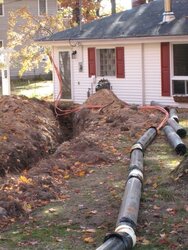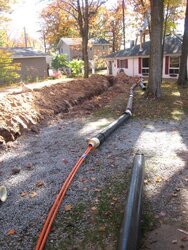I plan on putting in 6" SDR 35 pipe and putting the supply, return and boiler feed in it and foaming the 6" pipe with closed cell foam. It will be buried 4-5' deep and about 150' long.
My question is, if I just put my 1" supply, return and boiler feed line in the pipe, will the return and boiler feed suck heat from the supply? Should I put the supply in rubatex (~R2-3) inside of the the 6 inch pipe or should I just leave it without any extra insulation? I would like to keep it without in case I need to pull new line through in the future. I am also burying 1 1/2" ENT in case I need to run any signal wires between the shed and the house. I already have 2 sets of 12/2 UF wire going out to the shed. One for power and one for contact closure of the over temp Aquastat.
I need to change out my lines since I was losing so much heat last year underground. I hope I can make it through this winter with 7-8 full cords cut up for this season. I have about a 48K BTU heat loss from -30 to 70 degrees F parameters. Last year we had a lot of problems with the Seton. I also am working on re-insulating the Seton, it sure had a bunch of insulation missing from it. Must have been a Monday build.
My question is, if I just put my 1" supply, return and boiler feed line in the pipe, will the return and boiler feed suck heat from the supply? Should I put the supply in rubatex (~R2-3) inside of the the 6 inch pipe or should I just leave it without any extra insulation? I would like to keep it without in case I need to pull new line through in the future. I am also burying 1 1/2" ENT in case I need to run any signal wires between the shed and the house. I already have 2 sets of 12/2 UF wire going out to the shed. One for power and one for contact closure of the over temp Aquastat.
I need to change out my lines since I was losing so much heat last year underground. I hope I can make it through this winter with 7-8 full cords cut up for this season. I have about a 48K BTU heat loss from -30 to 70 degrees F parameters. Last year we had a lot of problems with the Seton. I also am working on re-insulating the Seton, it sure had a bunch of insulation missing from it. Must have been a Monday build.



